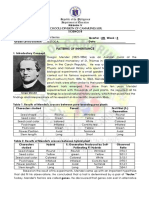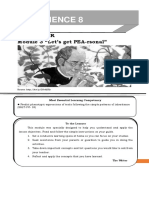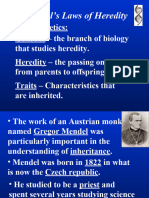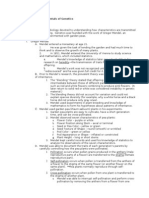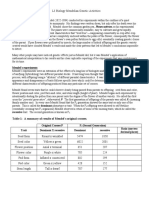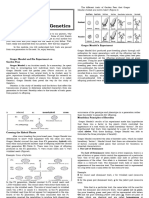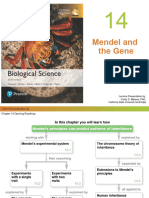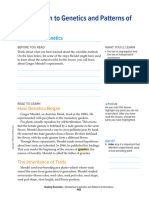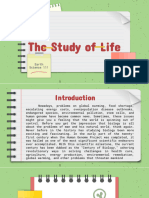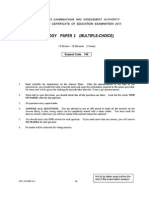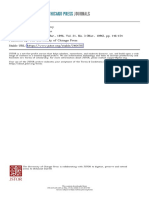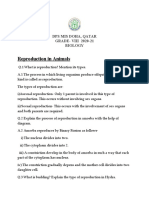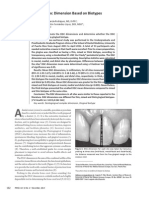Surigao Delnorte@deped Gov PH
Uploaded by
Matt AndreySurigao Delnorte@deped Gov PH
Uploaded by
Matt AndreyCOPYRIGHT 2020
Section 9 of the Presidential Decree No. 49 provides:
“No copy shall subsist in any work of the Government of the Philippines.
However, prior approval of the government agency or office wherein the work is created shall be necessary
for exploitation of such work for profit.”
The original version of this material has been developed in the Schools Division of Surigao del Norte through
the Learning Resource Management and Development Section of the Curriculum Implementation Division. This
material can be reproduced for educational purposes; modified for the purpose of translation into another language;
and creating of an edited version and enhancement of work are permitted, provided all original work of the author and
illustrator must be acknowledged and the copyright must be attributed. No work may be derived from any part of this
material for commercial purposes and profit.
This material has been approved and published for online distribution through the Learning Resource
Management and Development System (LRMDS) Portal (http://lrmds.deped.gov.ph) and Division Network Academy
(https://netacadsdn.com).
Development Team of the Module
Writer: Gregorio T. Llano Jr. & Sarah Jane B. Miasco
Editors: Jane Basul, Marcelina C. Ranin, Rey D. Arbolonio, Irene F. Havana,
Rosario P. Polea
Reviewers: Gersim S. Lumintac
Management Team: Ma. Teresa M. Real
Laila F. Danaque
Dominico P. Larong, Jr.
Gemma C. Pullos
Manuel L. Limjoco, Jr.
Printed in the Philippines by
Department of Education – Schools Division of Surigao del Norte
Office Address: Peñaranda St., Surigao City
Tel. No.: (086) 826-8216
E-mail Address: surigao.delnorte@deped.gov.ph
Author: Gregorio T. Llano Jr. & Sarah Jane B. Miasco
School: Surigao del Norte National High School
Division: Surigao del Norte
Email Address: gregorio.llano@deped.gov.ph/sarahjane.miasco@deped.gov.ph Page 1
LEARNING ACTIVITY SHEET
Science 8, Quarter 4, Week 3B
PREDICTING PHENOTYPIC EXPRESSION OF TRAITS
Name: __________________________________ Section: _________________________
Most Essential Learning Competency
Predict phenotypic expressions of traits following simple patterns of inheritance
(MELC S8LT-IVf-18)
Learning Objectives:
1. Describe simple pattern of inheritance;
2. Predict phenotypic expressions of traits following simple patterns of inheritance; and
3. Recognize the contribution of genetics to different fields.
Time Allotment: 2 Hours
Key Concepts
• Inheritance of traits dominated by a single gene with two alleles, one of which may be
fully dominant over the other, is known as simple (or Mendelian) inheritance.
Whether simple traits are controlled by genes on autosomes or genes on sex
chromosomes determines the pattern of inheritance. Simple inheritance refers to how
offspring inherit certain characteristics from their parents.
• Mendel got interested in peas and noted several of their distinguishing character traits.
A clearer picture of the traits is shown below:
Source: https://slideplayer.com/slide/4531250/
Figure 1. Mendel’s Pea Traits
Author: Gregorio T. Llano Jr. & Sarah Jane B. Miasco
School: Surigao del Norte National High School
Division: Surigao del Norte
Email Address: gregorio.llano@deped.gov.ph/sarahjane.miasco@deped.gov.ph Page 2
• Why do you think Mendel chose green peas for his experiments? Well, peas have
traits that are easily noticeable. They are easy to breed and grow, which make it easy
to reproduce new generations of peas in a short period of time and in large numbers. It
has been observed that pea plant normally pollinates itself because it has perfect
flowers, or flowers with both the male and female reproductive organs. The pollen
grains from the same flower can pollinate the eggs cells or ovules from the same
flower. However, to cross-pollinate, Mendel tried to remove the stamens while still
young. Then, when the pistil matured, he dusted it with the pollen grains from
another pea plant. In his first set of experiments, he needed to cross-pollinate pure
breeding pea plants. To get plants that are pure breeding, he allowed the pea plants to
self-pollinate for many generations. For instance, yellow seed peas were self-pollinated
until all the pea plants in a given generation produced all yellow seed peas. His
purpose here was to cross these pure breeding peas with other pure breeding peas and
observe the kind of offspring that will be produced.
• Monohybrid cross involves a cross using a single factor or character trait. How did
Mendel execute this? Well, after producing a pure breeding stock, he started crossing
or mating the pea plants. In this activity sheet, we will use X to represent crossing or
mating. The peas that he crossed had different expressions of a given trait like for
example, round or wrinkled seeds, green and yellow pods, etc (see figure 2). He
accomplished this by carefully cross-pollinating the peas by covering the flowers to
avoid accidental pollination from other peas. At first, he used only one trait like the
seed shape. So, he crossed a pure breed of round seeds with the pure wrinkled seeds.
He did this several times and from each cross he got the same result as shown in
Figure 2.
Figure 2. Mendel’s cross using pure-breed round and wrinkled seed peas
• The P1 in the cross stands for the first parents (the pure breeds). The F1 stands
for the first filial generation or first offspring. Notice that all the offspring are peas
with round seeds. These are also called as the hybrids because they are the result of a
cross between two pure-breeding plants. They resemble one another and one of the
parents. Mendel got similar results for all the seven pairs of traits he investigated, as
shown in Table 1.
Table 1. Mendel’s results of the cross between pure breed pea plants
TRAITS STUDIED PARENTS FIRST FILIAL GENERATION (F1)
SEED SHAPE Round X Wrinkled All round
SEED COAT COLOR Colored X White All colored
SEED COLOR Yellow X Green All yellow
POD SHAPE Inflated X Constricted All inflated
POD COLOR Yellow X Green All green
FLOWER POSITION Axial X Terminal All axial
STEM LENGTH Long X Short All long
Author: Gregorio T. Llano Jr. & Sarah Jane B. Miasco
School: Surigao del Norte National High School
Division: Surigao del Norte
Email Address: gregorio.llano@deped.gov.ph/sarahjane.miasco@deped.gov.ph Page 3
• A Punnett square is a chart that makes calculating the predicted genotype ratios in
the offspring of two parents easy. A cross is the product of two parents mating. The
Punnett square is named after Reginald C. Punnett, a British geneticist.
A Simplified Punnett Square
A. The basic step for a cross between two heterozygous axial flowers will be: Aa X Aa
1. Next, figure out the possible gamete genotype, and try to separate the alleles, just like
in the diagram below.
2. Place the possible gamete genotypes on the outside of a square.
3. Simulate fertilization by moving the gametes into each of the
internal boxes (which simulate possible offspring); interpret the
results.
Based on the results you will find out that there are three genotypes produced by
crossing two hybrids. 1 homozygous axial; 2 heterozygous axial and 1 homozygous
terminal flower.
• Using Punnett Squares to predict genotype and phenotype. In his pea plants,
Mendel introduced the law of segregation by focusing on a single trait, such as pod
color. The Punnett square in a monohybrid cross, such as the one shown in Figure 3,
shows any possible combination when one maternal (biological mother) allele is
combined with one paternal (biological father) allele. Both species are heterozygous for
flower color Bb in this case (purple). Any single offspring's chance of inheriting the
dominant trait is 3:1, or 75%.
Source:https://bio.libretexts.org/Bookshelves/Human_Biology/Book%3A_Human_Biology_(Wakim_and_Gre
wal)/08%3A_Inheritance/8.4%3A_Simple_Inheritance
Figure 3: This Punnett square shows a cross between two heterozygotes, Bb. To
develop a Punnett square, possible combinations of alleles in a gamete are placed
on the top and left side of a square.
• Cross with Two Factors (Dihybrid Cross). Mendel did not only study the inheritance
of one pair of factors or alleles. Pairs of alleles are used in a dihybrid cross. This
means there would be pairs of letters on the outside of the rectangle. A monohybrid
cross's Punnett square is divided into four squares, while a dihybrid cross's Punnett
square is divided into sixteen squares and so on. The squares are packed with allele
combinations that can occur when gametes merge, as in a zygote.
Author: Gregorio T. Llano Jr. & Sarah Jane B. Miasco
School: Surigao del Norte National High School
Division: Surigao del Norte
Email Address: gregorio.llano@deped.gov.ph/sarahjane.miasco@deped.gov.ph Page 4
• (Consider this cross) This cross focuses on two traits in peas:
✓ The trait for yellow peas (Y) is dominant to the trait for green peas (y).
✓ The trait for round peas (R) is dominant to the trait for wrinkled peas (r).
• Two generations of crosses are shown in Figure 4. Two homozygous plants are crossed
in the Parental (P) generation: a plant that produces yellow round peas (YYRR) is
crossed with a plant that produces green wrinkled peas (yyrr).
• To arrive at this:
✓ The parent with the YYRR genotype produces gametes that are all YR
✓ The parent with the yyrr genotype produces gametes that are all yr
✓ The YR and yr gametes produce YyRr offspring
Source:https://bio.libretexts.org/Bookshelves/Human_Biology/Book%3A_Human_Biology_(Wakim_and_
Grewal)/08%3A_Inheritance/8.4%3A_Simple_Inheritance
Figure 4: A Punnett square showing genotypes and phenotypes of parents
and offspring of a dihybrid cross
• There is another method for determining how characteristics are passed on from
generation to generation, a pedigree analysis. In a family, a pedigree indicates how a
trait is passed on from generation to generation. The information from a pedigree
makes it possible to determine how certain alleles are inherited: whether they are
dominant, recessive, autosomal, or sex-linked.
• The original pair is in the top row of a pedigree. A breeding pair is two people who are
bound by a horizontal line. The couple's children are connected to them by vertical
lines. The children of the pair, as well as their partners, are seen in the next row of the
pedigree. The third row of the pedigree depicts the following generation (the
grandchildren of the couple at the top of the pedigree). More rows showing additional
generations can be found in larger pedigrees. Widow's peak and freckles are two
single-gene autosomal features.
• An autosomal dominant trait pedigree as shown in Figure 7. This pedigree starts with
a male who is affected and a female who is not. The couple's first child (pictured on the
left) is an affected male with an unaffected female partner. They have two children: a
female who is affected and a male who is not. The following child is a child born to an
unaffected male and an unaffected female. Two unaffected females and one unaffected
male are their children. The following child is an affected female who is unmarried. The
fourth child is an unaffected female who is not in a relationship. The youngest child is
a female affected by the disease who is married to an unaffected male. Their children
Author: Gregorio T. Llano Jr. & Sarah Jane B. Miasco
School: Surigao del Norte National High School
Division: Surigao del Norte
Email Address: gregorio.llano@deped.gov.ph/sarahjane.miasco@deped.gov.ph Page 5
are an affected male, an unaffected male, an affected female, and an unaffected female,
in that order.
Source:https://bio.libretexts.org/Bookshelves/Human_Biology/Book%3A_Human_Biology_(Wakim_and_Grewal)/08%3A_I
nheritance/8.4%3A_Simple_Inheritance
Figure 5: Pedigree of an autosomal dominant trait
• What decides if a baby is a boy or a girl? Remember that you have 23 chromosome
pairs, one of which is the sex chromosomes. All has two sex chromosomes by default.
Males and females can have one less or one additional X chromosome due to
nondisjunction. You may have either X or Y chromosomes. Males have one X
chromosome and one Y chromosome (XY), while females have two X chromosomes
(XX).
• What is the sex of a child who inherits an X chromosome from the father and an X
chromosome from the mother? The baby will be female because it will have two X
chromosomes. The infant would be male if the father's sperm contains the Y
chromosome. Since a mother may only pass on an X chromosome, the father determines
the baby's gender. Since the parent has a 50% chance of passing on the Y or X
chromosome, there is a 50% chance that the child will be male and a 50% chance that
the child will be female. The Punnett square below illustrates this.
Figure 6: The X and Y chromosomes
determine male or female sexual
development. Males produce haploid
gametes (sperm) that are either 23, X or 23,
Y. Females produce haploid gametes (eggs)
that are 23, X. Daughters inherit an X
chromosome from their mother and an X
chromosome from their father. Sons inherit
an X chromosome from their mother and a Y
chromosome from their father (paternal
chromosomes indicated in white, maternal
chromosomes indicated in black)
Source:https://bio.libretexts.org/Bookshelves/Human_Biology/Book%3A_Human_Biology_(Wakim_and_Grewal)/08%
3A_Inheritance/8.4%3A_Simple_Inheritance
• X-Linked Mendelian Traits in Humans. Red-green colorblindness is an example of a
sex-linked trait. This form of colorblindness prevents people from distinguishing
between red and green. These colors are mostly perceived as brown shades by them.
• Since colorblindness is a sex-linked, recessive trait, males are much more likely than
females to be colorblind. Males have only one allele for every X-linked trait since they
only have one X chromosome. As a result, males often display a recessive X-linked
allele. Females have two alleles for every X-linked trait since they have two X
chromosomes. One X chromosome with the colorblind gene and one X chromosome
with a regular gene for color vision can be found in females. The dominant normal
Author: Gregorio T. Llano Jr. & Sarah Jane B. Miasco
School: Surigao del Norte National High School
Division: Surigao del Norte
Email Address: gregorio.llano@deped.gov.ph/sarahjane.miasco@deped.gov.ph Page 6
gene would mask the recessive colorblind gene because colorblindness is recessive.
Carriers are women who have one colorblindness allele and one regular allele. They
have the allele but don't show it. To display an X-linked recessive gene, females must
inherit two copies of the recessive allele. This explains why females have less X-linked
recessive traits than males and why they have a different inheritance pattern than
autosomal traits.
• The son of a woman with the colorblindness trait and a male with normal vision has a
50% risk of becoming colorblind, according to this Punnett square (Table 2). A basic
pedigree for this trait is shown in Figure 10.
Table 2: Punnet Square for color blindness
Xb XB
XB XbX XBXB
(carrier female) (normal female)
Y XbY XBY
(colorblind male) (normal male)
Figure 7: Pedigree for Color Blindness.
Color blindness is an X-linked
recessive trait. A carrier mother and
unaffected father can produce
unaffected sons and daughters, carrier
daughters, and colorblind sons.
Source:https://bio.libretexts.org/Bookshelves/Human_Biology/Book%3A_Human_Biology_(Wakim_and_G
rewal)/08%3A_Inheritance/8.4%3A_Simple_Inheritance
• Hemophilia is another example of a recessive X-linked Mendelian trait. The failure of
blood to clot normally is a symptom of this condition. Queen Victoria of England was
afflicted with the disease. Two of Queen Victoria's five daughters were carriers of the
hemophilia mutation inherited from their mother. They spread the allele throughout
Europe when they married royalty from other European countries, including the royal
families of Spain, Germany, and Russia. Prince Leopold, Victoria's son, inherited the
hemophilia allele from his mother and was diagnosed with the disease. Hemophilia
was once known as "the royal illness" because of these factors.
• It's important to comprehend inheritance patterns in order to appreciate how
circumstances are passed down in a family. A complete family health history is a
useful tool for demonstrating how diseases are passed down through the generations.
Furthermore, a family background may aid in the exclusion of genetic diseases,
especially in the case of common diseases in which behavior and environment play a
significant role.
Author: Gregorio T. Llano Jr. & Sarah Jane B. Miasco
School: Surigao del Norte National High School
Division: Surigao del Norte
Email Address: gregorio.llano@deped.gov.ph/sarahjane.miasco@deped.gov.ph Page 7
Activity 1. Guess What!
Objective: The learners will be able to describe simple pattern of inheritance.
What you need: Paper and pen
What to do: Answer the questions below based on your understanding.
1. Simple (or Mendelian) inheritance refers to the inheritance of traits controlled by a single
gene with two alleles, one of which may be completely dominant to the other. The pattern
of inheritance of simple traits depends on whether the traits are controlled by genes on
autosomes or by genes on sex chromosomes. Simple pattern of inheritance refers to how
offspring inherit certain characteristics from their parents. Based on its definition and the
concepts learned in the previous module, complete the concept map below by supplying
terms that best describes simple pattern of inheritance. (Use separate sheet if necessary)
SIMPLE PATTERN
OF INHERITANCE
Activity 2. Let’s do this!
Objective: Predict phenotypic expressions of traits following simple patterns of
inheritance
What you need: Paper and pen
What to do: Supply the pedigree, phenotypic and genotypic expressions of traits
in the following problem sets.
1. In pea plants, round seed shape (R) is dominant over wrinkled (r). Write the genotype and
phenotype for a plant that is:
a) heterozygous (hybrid): _____________________________
b) homozygous dominant (pure): _____________________________
c) homozygous recessive (pure): _____________________________
Author: Gregorio T. Llano Jr. & Sarah Jane B. Miasco
School: Surigao del Norte National High School
Division: Surigao del Norte
Email Address: gregorio.llano@deped.gov.ph/sarahjane.miasco@deped.gov.ph Page 8
2. In pea plants, tall (T) is dominant over short (t). Cross a pure tall plant with a pure short
plant. Find the genotype and phenotype ratio of the resulting offspring by completing the
missing letter. Rewrite your answer in the given blank below.
CROSS: Example: Bb x Bb (see figure 3) Do this: TT x tt
B b
B BB Bb
b Bb bb
Phenotypic ratio: 3 Purple flower, 1 white flower Phenotypic ratio: __________________
Genotypic ratio: 1 BB, 2 Bb, and 1 bb Genotypic ratio: ___________________
3. Answer the following dihybrid cross problems (see figure 4 for your reference):
Author: Gregorio T. Llano Jr. & Sarah Jane B. Miasco
School: Surigao del Norte National High School
Division: Surigao del Norte
Email Address: gregorio.llano@deped.gov.ph/sarahjane.miasco@deped.gov.ph Page 9
4. Make a pedigree for left-handedness using information of the Thomas family:
The father, Tomas, and mother, Sana, have three daughters. The two oldest children are
Anna and Maria and the youngest child is Tado. The oldest daughter, Anna, is married
and has an older son, Willie, and younger daughter, Vanessa. Maria is also married and
has a son, Patrick. Tado is not yet married. Everyone in this family is right handed except
the father, the oldest daughter, and the granddaughter. Right-handedness is dominant.
Guide Questions:
1. Identify the genotypes of the father, eldest daughter, and granddaughter.
________________________________________________________________________________________
________________________________________________________________________________________
2. What is the genotype of Sana, Maria, and Tado?
________________________________________________________________________________________
________________________________________________________________________________________
3. What is a pedigree, and why is it useful for studying how traits are passed from one
generation to the next?
________________________________________________________________________________________
________________________________________________________________________________________
________________________________________________________________________________________
_______________________________________________________________________________________.
4. What is a Punnett square, and what does it show?
________________________________________________________________________________________
________________________________________________________________________________________
________________________________________________________________________________________
_______________________________________________________________________________________.
Author: Gregorio T. Llano Jr. & Sarah Jane B. Miasco
School: Surigao del Norte National High School
Division: Surigao del Norte
Email Address: gregorio.llano@deped.gov.ph/sarahjane.miasco@deped.gov.ph Page 10
Activity 3. I am important, because?
What to do: (REFLECTION) Recognize the importance of understanding the simple patterns of
inheritance based on the questions indicated below.
1. Why it is important to understand the patterns of inheritance?
_______________________________________________________________________________________________
_______________________________________________________________________________________________
_______________________________________________________________________________________________
2. What are contributions of genetics to different fields?
_______________________________________________________________________________________________
_______________________________________________________________________________________________
_______________________________________________________________________________________________
Scoring Rubric
10 points Explanation is scientifically consistent with the concepts and has no
misconception.
7 points Explanation is scientifically consistent with the concepts but with
minimal misconception.
5 points Explanation is scientifically consistent with the concepts but with
misconception.
References for Learners:
Wakim, S. & Grewal, M. (2021). Simple inheritance. Biology Libretexts, accessed April
8, 2021, https://bio.libretexts.org/Bookshelves/Human_Biology/Book%3A_
Human_Biology_(Wakim_and_Grewal)/08%3A_Inheritance/8.4%3A_Simple_Inheritance
Online Resources:
• https://www.cantonschools.net/cms/lib/MS01910483/Centricity/Domain/4/McAllister
Genetics.pdf
• https://www.wlwv.k12.or.us/cms/lib/OR01001812/Centricity/Domain/1341/HANDOU
T%20-%20GENETICS%20PROB%20SET%202.pdf
Author: Gregorio T. Llano Jr. & Sarah Jane B. Miasco
School: Surigao del Norte National High School
Division: Surigao del Norte
Email Address: gregorio.llano@deped.gov.ph/sarahjane.miasco@deped.gov.ph Page 11
Answer Key:
Activity 1. Guess What!
1. (Answer may vary)
alleles
annd recessive
Dominant
expression traits
phenotypic heterozygous
Genotypic and Homozygous and
square
resemblance OF INHERITANCE and punnet
External SIMPLE PATTERN Pedigree analysis
characteristics heredity
Unique Genetics and
parents
from the
Inherited traits
Author: Gregorio T. Llano Jr. & Sarah Jane B. Miasco
School: Surigao del Norte National High School
Division: Surigao del Norte
Email Address: gregorio.llano@deped.gov.ph/sarahjane.miasco@deped.gov.ph Page 12
Page 13 Email Address: gregorio.llano@deped.gov.ph/sarahjane.miasco@deped.gov.ph
Division: Surigao del Norte
School: Surigao del Norte National High School
Author: Gregorio T. Llano Jr. & Sarah Jane B. Miasco
Activity 2. Let’s do this!
1. In pea plants, round seed shape (R) is dominant over wrinkled (r). Write the genotype
and phenotype for a plant that is:
a) heterozygous (hybrid): Rr
b) homozygous dominant (pure): RR
c) homozygous recessive (pure): rr
2. In pea plants, tall (T) is dominant over short (t). Cross a pure tall plant with a pure
short plant. Find the genotype and phenotype ratios.
CROSS: TT x tt
genotype ratio: 4 Tt (all hybrid (heterozygous))
phenotype ratio: all tall
T T
t Tt Tt
t Tt Tt
3.
Ggbb – Gray hair and red eyes
ggbb - White hair and red eyes
ggBB – White hair and black eyes
GgBb – Gray hair and black eyes
Page 14 Email Address: gregorio.llano@deped.gov.ph/sarahjane.miasco@deped.gov.ph
Division: Surigao del Norte
School: Surigao del Norte National High School
Author: Gregorio T. Llano Jr. & Sarah Jane B. Miasco
Activity 3. I am important, because? (Answers may vary)
1. It is important to understand the patterns of inheritance to appreciate how conditions
are passed on in a family. An accurate family health history is a valuable tool to
illustrate how conditions are passed down through generations.
2. A family history can even help to exclude genetic diseases, particularly for common
diseases where behavior and environment play strong roles. Generally, genetic variation
is important for the survival of all species (plants and animals) so that they will not
become extinct. Genetic variation is simply the differences in each individual in terms of
alleles. Through this genetic variation, some animals have better immune system, or
longer limbs, faster runners compared to the others. The same concept can be applied
to plants as well (taller, or more resistant to pests).
4. (Activity 2)
(You can use any letter as representation)
1. Heterozygous dominant (Mm)
2. Homozygous recessive (mm)
Guide Questions (Activity 2)
1. A pedigree is a chart that shows the inheritance of a trait over several generations. A
pedigree is commonly created for families, and it outlines the inheritance patterns of
genetic disorders and traits. A pedigree can help predict the probability that offspring
will inherit a genetic disorder.
2. The Punnett square is a square diagram that is used to predict the genotypes of a
particular cross or breeding experiment. It is named after Reginald C. Punnett, who
devised the approach in 1905. The diagram is used by biologists to determine the
probability of an offspring having a particular genotype.
1.
You might also like
- Grade 8 Q4 Module 3 Mendelian Genetics 2ND EdNo ratings yetGrade 8 Q4 Module 3 Mendelian Genetics 2ND Ed20 pages
- Biology Form 5: 5.1: MENDEL'S ExperimentNo ratings yetBiology Form 5: 5.1: MENDEL'S Experiment29 pages
- Q4 SCIENCE8 MELC-NO.-23 WEEK-NO.-3 ACTIVITY-NO.3 v2No ratings yetQ4 SCIENCE8 MELC-NO.-23 WEEK-NO.-3 ACTIVITY-NO.3 v24 pages
- Principles of Inheritance and VariationNo ratings yetPrinciples of Inheritance and Variation31 pages
- Science 8 q4 Wk3 Mendelian and Non Mendelian Genetics - Cqa.gqa - LrqaNo ratings yetScience 8 q4 Wk3 Mendelian and Non Mendelian Genetics - Cqa.gqa - Lrqa15 pages
- Biology Chapter 9 Fundamentals of GeneticsNo ratings yetBiology Chapter 9 Fundamentals of Genetics6 pages
- Prezantacija 3 Osnovni Principi Nasledjivanja I Interakcije Alela Unutar Jednog Gena I Interakcije Medju GenimaNo ratings yetPrezantacija 3 Osnovni Principi Nasledjivanja I Interakcije Alela Unutar Jednog Gena I Interakcije Medju Genima41 pages
- Genetics: Inheritance of Traits Mendel's Law of Inheritance100% (1)Genetics: Inheritance of Traits Mendel's Law of Inheritance54 pages
- DETAILED LESSON PLAN IN SCIENCE (Medelian Principles)No ratings yetDETAILED LESSON PLAN IN SCIENCE (Medelian Principles)12 pages
- Science 8 Learning Activity Sheet Quarter 4 Week 3100% (2)Science 8 Learning Activity Sheet Quarter 4 Week 33 pages
- Principles of Inheritance and VariationNo ratings yetPrinciples of Inheritance and Variation20 pages
- Cells and Heredity Chapter Three Genetics The Science of HeredityNo ratings yetCells and Heredity Chapter Three Genetics The Science of Heredity34 pages
- Genetics: Studies of Similarities and DifferencesNo ratings yetGenetics: Studies of Similarities and Differences25 pages
- Infant Care and Feeding PPT 2021 Part 2No ratings yetInfant Care and Feeding PPT 2021 Part 2236 pages
- Dianne Gay Leaño 23 Years Old FSUU Batch 2017 November 2017 PNLE (85.20)No ratings yetDianne Gay Leaño 23 Years Old FSUU Batch 2017 November 2017 PNLE (85.20)213 pages
- Report 1: Practical 1: Microscopy, Cell Observation & OsmosisNo ratings yetReport 1: Practical 1: Microscopy, Cell Observation & Osmosis8 pages
- Production of Chitinase by Serratia Marcescens From Soil and Its Antifungal ActivityNo ratings yetProduction of Chitinase by Serratia Marcescens From Soil and Its Antifungal Activity9 pages
- INTROPSY Reviewer (Book-Based Only) Chapters 1-2No ratings yetINTROPSY Reviewer (Book-Based Only) Chapters 1-212 pages
- Dispersal's Role in Life History EvolutionNo ratings yetDispersal's Role in Life History Evolution9 pages
- Reading - Cas - Text Structure and PurposeNo ratings yetReading - Cas - Text Structure and Purpose5 pages
- Harshberger - 1896 - The Purposes of Ethno-BotanyNo ratings yetHarshberger - 1896 - The Purposes of Ethno-Botany10 pages
- Reproduction in Animals CLASS VIII NOTESNo ratings yetReproduction in Animals CLASS VIII NOTES7 pages
- Multidimensional Personality Assessment 1No ratings yetMultidimensional Personality Assessment 15 pages
- (1032) Development and Design of BioassaysNo ratings yet(1032) Development and Design of Bioassays15 pages
- Animals Used in Experimental Pharmacology and 3 RsNo ratings yetAnimals Used in Experimental Pharmacology and 3 Rs7 pages
- DentogingivalComplex - Dimension Based On BiotypesNo ratings yetDentogingivalComplex - Dimension Based On Biotypes5 pages
- Insulin-Transferrin-Selenium Supplement (100X) Insulin-Transferrin-Selenium-A Supplement (100X) Insulin-Transferrin-Selenium-X Supplement (100X)No ratings yetInsulin-Transferrin-Selenium Supplement (100X) Insulin-Transferrin-Selenium-A Supplement (100X) Insulin-Transferrin-Selenium-X Supplement (100X)2 pages
